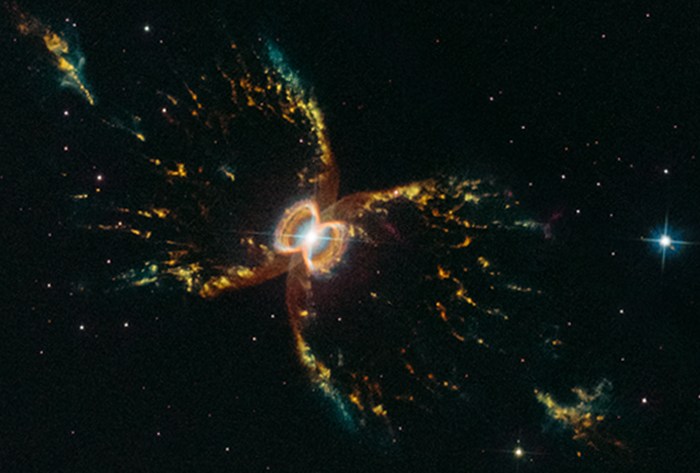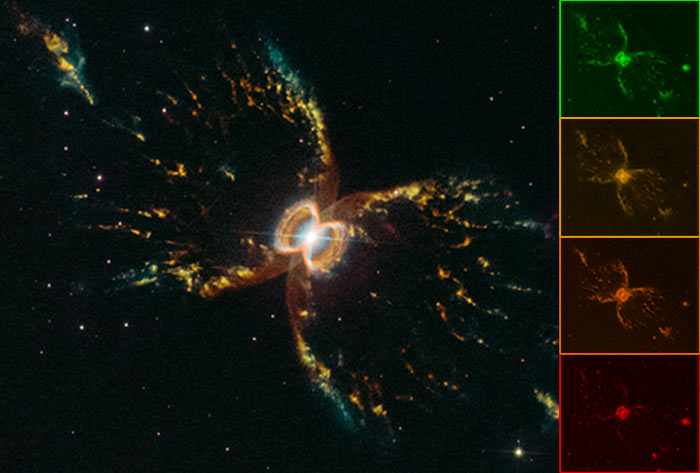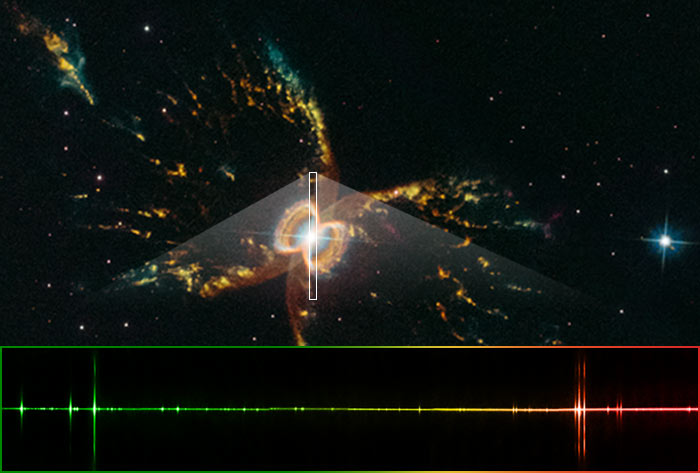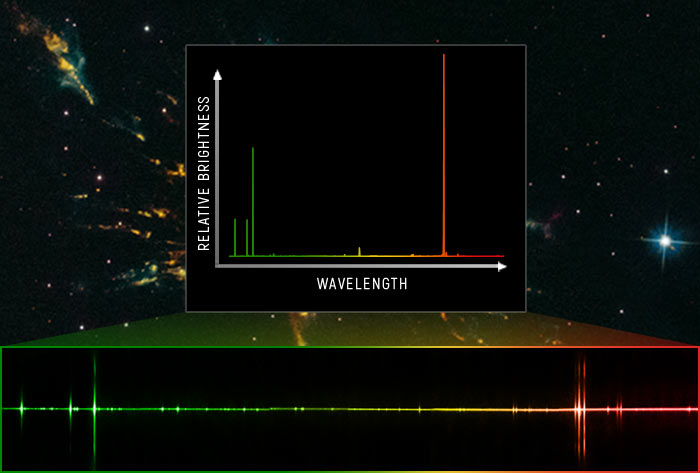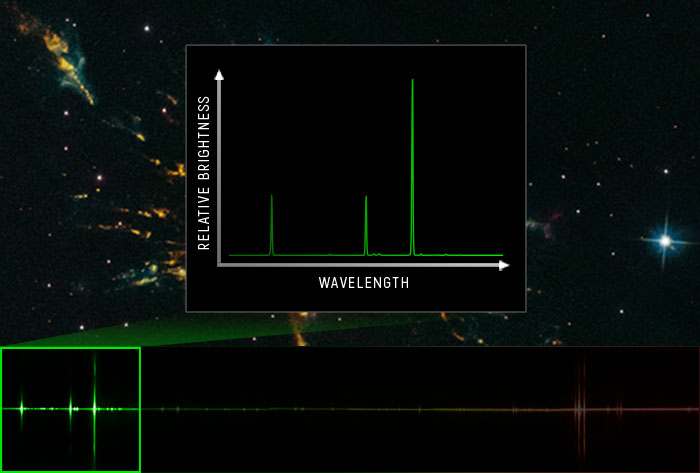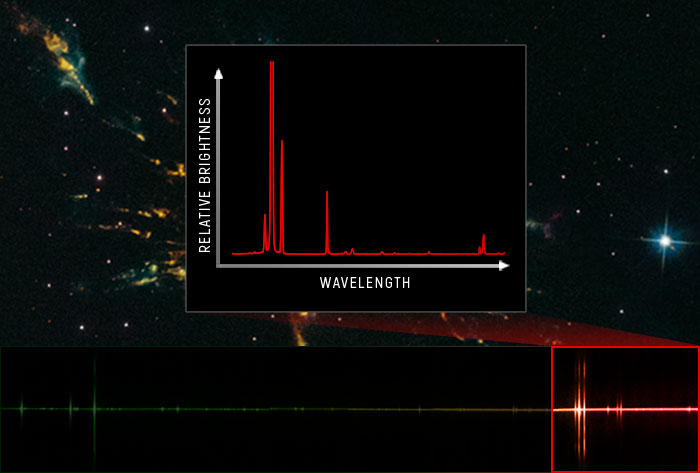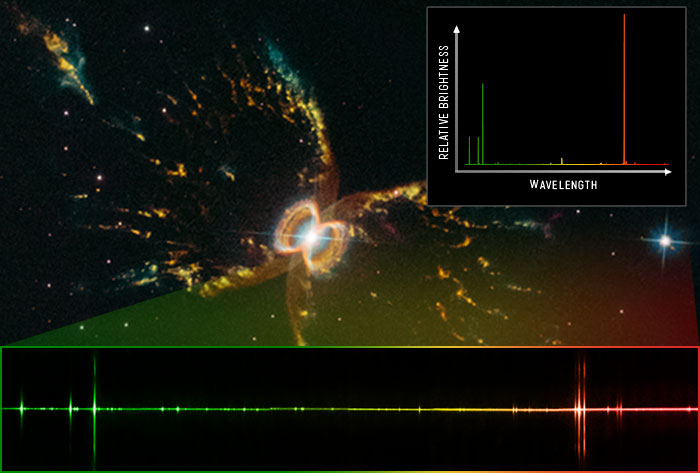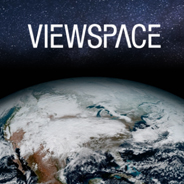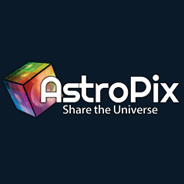Interactive Overview
Slider Interactive: A series of images showing the steps in creating a spectrum of the Southern Crab Nebula, with certain portions highlighted. Below the caption is a horizontal slider bar with six labeled stops and a solid white circle. Dragging the white circle right and left along the slider bar causes the image, labels, and caption to change. The change occurs gradually as one image, along with its associated captions and labels, fades out and the next fades in. A toggle button to the upper right of the image turns the image labels off and on. Labels are in the form of text with arrows pointing to specific features in the image. Other labels are graphic overlays.
Slider Stops
From left to right, the slider stops are labeled: Multicolor image, Spreading out the light, Plotting the light, Green spectrum, Red spectrum, and Multicolor spectrum.
Summary of Slider Stops
Sliding left to right reveals the following:
- “Multicolor image” stop shows a colorful image of the Southern Crab Nebula. This is the initial image shown when the interactive is loaded.
- “Spreading out the light” stop shows a highlighted section of the nebula and a corresponding colorful spectrum in a black box at the bottom.
- “Plotting the light” stop shows the same spectrum at the bottom of the image and a line graph above it, which shows the brightness of different wavelengths of light emitted from that portion of the nebula.
- “Green spectrum” stop shows the green section of the spectrum highlighted, with a graph above that displays the distinct peaks in the spectrum.
- “Red spectrum” stop shows the red section of the spectrum highlighted, with a graph above that displays the distinct peaks in the spectrum.
- “Multicolor spectrum” stop shows the entire spectrum of the nebula, a graph showing the different levels of brightness over different wavelengths, and a colorful image of the nebula.
Stop 1: Multicolor image
Image Description: Multicolor image
Image of the Southern Crab Nebula against a black background. The center of the nebula is shaped like an hourglass, the thinnest area having a bright white circular core. Colorful material resembling streaks and blobs extend in semicircles from the center to the left and right: yellow, orange, and green. The overall shape is similar to a butterfly’s wings, roughly symmetrical. Small white points of light are scattered across the background.
Labels: Multicolor image
There are two text labels and four graphic overlays. The bright core of the nebula is labeled “Central stars.” The semicircle on the left side of the nebula’s core is labeled “Ejected gas.” The graphic overlays consist of four single-color images of the nebula, which form a vertical bar to the right of the image and include or exclude different features. From top to bottom the color of the boxes and the nebula are: green, yellow, orange, and red. Each single-color image matches up with the respective colorful elements in the Southern Crab Nebula image.
Caption: Multicolor image
Scientists combined images of four separate colors to reveal structural details of the Southern Crab Nebula.
Stop 2: Spreading out the light
Image Description: Spreading out the light
This stop shows the same image of the Southern Crab Nebula. An outline of a thin vertical rectangle lies on the bright white circular core of the nebula. A white shaded triangular area emanates from the left and right sides of the rectangle, connecting the highlighted area of the image to a spectrum in a black box below. The spectrum is a thin, colorful horizontal line, beginning with green at the left and gradually changing to yellow and then red at the rightmost end. Thin vertical lines of different heights that extend above and below the line run across the span of the horizontal line.
Labels: Spreading out the light
There are two text labels. The vertical bar that highlights a narrow area of the nebula’s center is labeled “Small section of the nebula.” At the bottom, the black box with the thin colorful line is labeled “Light divided into many colors.”
Caption: Spreading out the light
An instrument inside a telescope captures light from a small part of the nebula and spreads it out into its individual colors.
Stop 3: Plotting the light
Image Description: Plotting the light
This stop shows the same image of the Southern Crab Nebula. The image is overlaid with a line graph. The y-axis is labeled “Relative brightness” and the x-axis is labeled “Wavelength.” The graph shows a thin, colorful horizontal line, beginning with green at the left and gradually changing to yellow and then red at the rightmost end. Thin peaks of different heights run across the span of the horizontal line. There are three tall peaks in the green section on the left. The tallest peak is toward the right in the red section. At the bottom is the spectrum within a black box, which has a similar horizontal line that follows the gradual changing colors as in the line graph. Thin vertical lines of different heights also run across the span of the horizontal line, extending above and below the line. These vertical lines match the positions of the peaks in the graph: The heights of the lines and peaks are correlated.
Labels: Plotting the light
There are three text labels. The line graph is labeled “Spectrum.” A flat part of the graph’s line is labeled “Low light level,” while a tall peak on the graph is labeled “High light level.”
Caption: Plotting the light
Astronomers can measure the amount of light emitted at each color (wavelength) and display it in a plot, called a spectrum.
Stop 4: Green spectrum
Image Description: Green spectrum
This stop shows the same image of the Southern Crab Nebula with the same spectrum in a black box toward the bottom. Only the left side of the box, the green portion, is highlighted. The image is overlaid with a line graph in green that displays only that portion of the spectrum. The y-axis is labeled “Relative brightness” and the x-axis is labeled “Wavelength.” The line has a total of three tall peaks, the first two similar in size, and the third about three times their height.
Labels: Green spectrum
There are two text labels. On the line graph, the green line’s first distinct peak is labeled “Hydrogen,” while the third peak is labeled “Oxygen.”
Caption: Green spectrum
Heated elements emit specific colors and appear as brighter peaks in the green spectrum.
Stop 5: Red spectrum
Image Description: Red spectrum
This stop shows the same image of the Southern Crab Nebula with the same spectrum in a black box toward the bottom. Only the right side of the box, the red portion, is highlighted. The image is overlaid with a line graph in red that displays only that portion of the spectrum. The y-axis is labeled “Relative brightness” and the x-axis is labeled “Wavelength.” The line has many peaks, most of them toward the left side of the graph.
Labels: Red spectrum
There are two text labels. On the line graph, the tallest red peak is labeled “Hydrogen,” and extends toward the top of the graph. A smaller peak near the middle of the line is barely distinguishable at this scale and labeled “Sulfur.”
Caption: Red spectrum
Bright peaks in this spectrum are not all the same brightness, an important detail for astronomers.
Stop 6: Multicolor spectrum
Image Description: Multicolor spectrum
This stop shows the same image of the Southern Crab Nebula. The line graph and spectrum from the “Plotting the light” stop also appear here. The line graph is located in the top right corner. The y-axis is labeled “Relative brightness” and the x-axis is labeled “Wavelength.” The graph shows a thin, colorful horizontal line, beginning with green at the left and gradually changing to yellow and then red at the rightmost end. Thin peaks of different heights run across the span of the horizontal line. There are three tall peaks in the green section on the left. The tallest peak is toward the right in the red section. Similar to the “Plotting the light” stop, the spectrum is in a black box at the bottom, which has a similar horizontal line that follows the gradual changing colors as in the line graph. Thin vertical lines of different heights also run across the span of the horizontal line, extending above and below the line. These vertical lines match the positions of the peaks in the graph: The heights of the lines and peaks are correlated.
Labels: Multicolor spectrum
There are two text labels. The line graph of the spectrum in the top right is labeled “A spectrum reveals gas properties.” In the image of the nebula, a yellow and blue-green blob at the top left corner is labeled “An image reveals structural features.”
Caption: Multicolor spectrum
A complete spectrum shows the brightness of each color (wavelength) and can reveal details about the nebula that an image cannot.
